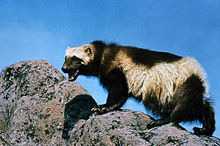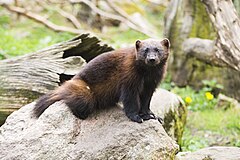Wolverine
| Wolverine | |
|---|---|

| |
| Scientific classification | |
| Domain: | Eukaryota |
| Kingdom: | Animalia |
| Phylum: | Chordata |
| Class: | Mammalia |
| Order: | Carnivora |
| Family: | Mustelidae |
| Genus: | Gulo |
| Species: | G. gulo
|
| Binomial name | |
| Gulo gulo | |
| Subspecies | |
|
G. g. luscus | |

| |
| Wolverine ranges | |
| Synonyms | |
|
Mustela gulo Linnaeus, 1758 | |
The wolverine or glutton (Gulo gulo) is the largest member of the Mustelidae family (the weasels). It is a stocky and muscular carnivore, more like a small bear than other mustelids. The wolverine, a solitary animal, has a reputation for ferocity, and can kill prey many times larger than itself. It is a powerful and versatile predator and scavenger.
There is a clear difference between two subspecies: the Old World form Gulo gulo gulo and the New World form G. g. luscus.[1]
The male is about 18 in (46 cm) tall, the female 14 in (36 cm). Their length ranges from 36 in (91 cm) (female) to 45 in (110 cm) (male) and they reach a weight of around 25–36 lb (11–16 kg). Their tail measures about 8 in (20 cm). Their brown fur protects them from the extremely cold temperatures and their big feet enable them to walk on top of snow.
Distribution[change | change source]

Wolverines live primarily in isolated arctic and alpine regions of northern Canada, Alaska, Siberia, and Scandinavia. they are also native to European Russia, the Baltic countries, northeast China and Mongolia. In 2008 and 2009, wolverines were sighted as far south as the Sierra Nevada, near Lake Tahoe, for the first time since 1922.[2][3][4] They are also found in low numbers in the Rocky Mountains and northern Cascades of the United States, and have been sighted as far south and east as Michigan.[5] However, most New World wolverines live in Canada.
Wolverines feed on almost every type of food that they can find: mice, rats, birds, bird eggs, reindeer and other large prey. Wolverines prefer to hunt larger prey in winter, when the snow slows down the prey and gives the wolverine an advantage.
Wolverines are highly territorial.[6] Wolverines reproduce every two or three years. The female gives birth to one to three young (called kits) in a tunnel called a den deep underneath snowdrifts.
Protection[change | change source]
Humans are the wolverine’s main enemy. The wolverine’s thick, warm fur is used to manufacture the trim of a parka's hood or other winter clothes, as the dense guard hairs do not collect frost.
In February 2013, the United States Fish and Wildlife Service proposed giving Endangered Species Act protections to the wolverine largely because climate change (global warming) is whittling away its wintry habitat in the northern Rockies.[7][8] Wolverines have poor eyesight but a keen sense of smell, they can smell prey 20 feet under the snow.
References[change | change source]
- ↑ 1.0 1.1 Abramov A; Belant J; Wozencraft C. (2009). "Gulo gulo". IUCN Red List of Threatened Species. Version 2009.2. International Union for Conservation of Nature. Retrieved 2010-01-25.
- ↑ Knudson, Tom (5 April 2008). "Sighting prompts California to expand search for elusive wolverine". Sacramento Bee. Archived from the original on 30 July 2013. Retrieved 5 September 2015.
- ↑ Griffith, Martin (22 March 2009). "A year later, wolverine spotted again in Sierra". San Francisco Chronicle. Archived from the original on 26 April 2009. Retrieved 5 September 2015.
- ↑ Wolverine Sighting on SPI Land near Truckee Archived 2011-02-06 at the Wayback Machine 18 Mar 2009
- ↑ Runk, David. (2004-02-25) First Michigan wolverine spotted in 200 years – Technology & science – Science – msnbc.com. MSNBC. Retrieved on 2011-09-16.
- ↑ "Wolverines". Montana Department of Fish, Wildlife and Parks. fwp.mt.gov. Archived from the original on 2013-09-28. Retrieved 2009-07-07.
- ↑ U.S. proposes to protect wolverines February 1, 2013 New York Times
- ↑ Judge Prods Wildlife Service on Protection for Wolverines April 7, 2016



